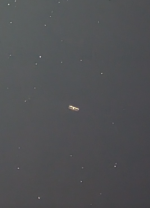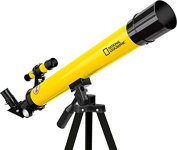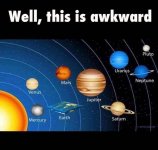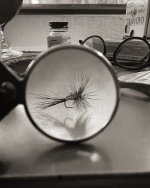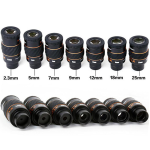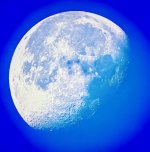T'SCOPES - I see all sorts of eye pieces - singles and sets - all over Amazon. Would you give me an idea of what the ballpark price range of 'not cheap' eye pieces would be? I haven't the foggiest. - Sherm Natman
@Briar Lee asked me a similar question the other day. It's a difficult question to answer, partially because I haven't had to purchase new ones in over 12 years - they last a long time if cared for - but I can give you a couple of considerations you should ask yourself. First, are you looking for 1.25 inch or 2 inch eye pieces. I find the 2 inch are much better for my older eyes. Secondly, it really has to do with the focal length of your scope and how it will interact with the eye piece, your magnification will be determined by the combination of those two f/l variables.
"Simple Math For Determining The Focal Length For Your Telescope Eyepiece
An eyepiece is defined by its focal length, apparent field of view, and barrel size, but how do you know whether it's right for your telescope? First of all, you need to know the magnification that will result if you pair an eyepiece you are considering with your telescope. The math is easy division; take your telescope's focal length in millimeters and divide it by the focal length of the eyepiece, also in millimeters. For instance: a telescope with a focal length of 500mm divided by a 10mm eyepiece will yield 50X magnification. Simple."
Personally, unless I am splitting binary stars, I prefer low power setups. Also, if I am looking for deep space objects, again, lower power set ups are best for me.
The overriding factor then becomes a lens that can filter out light pollution, highlight the spectrum of light look are looking to see, i.e. galaxies versus nebulas, planets, the moon, etc as well as the quality of the lens itself.
How do you put a price on these factors? I personally prefer a better quality lens with a low power that I can slip onto a Barlow Lens and use at a higher power if needed. It's like having twice as many eyepieces. Don't expect to find a quality lens for much under $100 dollars. Expect to see better ones at double that price. Again, I am using numbers from ten years ago, so who knows. I will tell you that experience doing this as a hobby for 40 years has taught me that the telescope is for all intensive purpose the aperture of the scope, the quality of the mirror, and the eye piece. Everything comes together at your eye. This is where the picture is finalized. Can you find a cheaper eye piece that will work? Yes, but you get what you pay for. When you are out late at night, far from home, alone in the woods, desert, or high on a mountain in the MF'in freezing cold, you want to see what you came to see. Missing out because your scope or eyepiece wasn't up to the task means going home tired, cold, fatigued, and frustrated.
I find most cheap scopes skimp on the eye piece because the real cost of the scope, where it really matters after the quality of the mirrors, is the eye piece. If your scope is a refractor, good luck. Hopefully, the quality of the lenses in the tube are up to snuff.
Most things you will be looking to see are invisible to the naked eye. A good quality finder scope mounted on the side of the scope is a life saver. Think about this as well.
Telescopes are NOT pipes. Briar is briar. A quality piece of glass is not just silicone. It has various gases and elements infused into the glass to serve as filters as well as provide a more keener focus for contrast.
This is probably not what you wanted to hear or read.
Try to get the best eyepiece you are willing to pay. Make sure you don't go for too much power - especially with a cheaper scope. It will magnify the inherent errors built into the scope itself and that is frustrating. If the moon is what you are looking at, you needn't worry. But if you want to truly see the red spot on Jupiter or the planets around Jupiter and Saturn as well as really see the rings, a better eyepiece will help take what would otherwise be a blur and create some nice contrast between the rings or the storm. Nebulas - These can be a lot of fun. Do you want to clearly see the horse head ? Are you wanting to see a spiral arm of M31 or just a purple smudge?
Lastly, try to get two eye pieces. One for planets - higher power - and one for deeper space objects - lower power. You can use both once you find what you are looking for and will be thankful to have the options.
I hope this helps. It is a fascinating hobby. It is also a frustrating hobby - and it is one best shared with a friend. It helps to have someone assisting you, especially on cold nights when the cold rips through you.
And keep a pipe handy. I always smoke a pipe when I am sky gazing.









